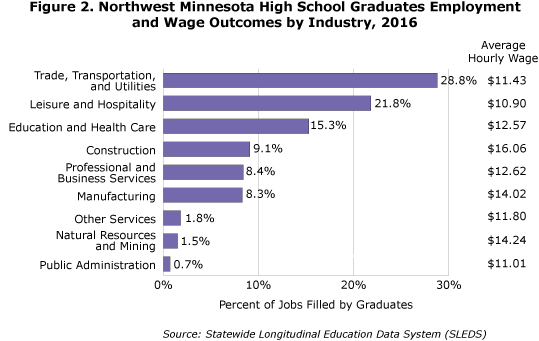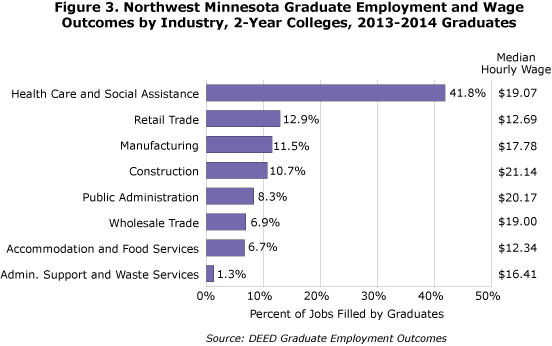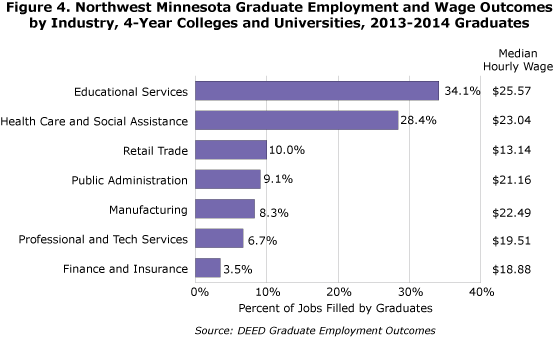by Chet Bodin
October 2018
Students everywhere, from the time they are young, are encouraged to start thinking about their future, often focusing on what sort of career they are interested in pursuing. In today’s economy a plethora of employers near and far are ready to enlist these students as soon as they graduate.
According to DEED’s Job Vacancy Survey, a record number of job opportunities have been posted in Minnesota this year. The most recent survey from the second quarter of 2018 estimates just over 142,000 vacancies throughout the state, which was nearly 20,000 more than the number of job openings in the second quarter of the prior year and almost 30,000 more than the fourth quarter of 2017.
Northwest Minnesota is no exception. Three of the four economic development regions reported a record number of openings in the latest survey, over 14,000 vacancies in the 26-county region, spread across several different industries (see Table 1). That was nearly 3,500 more vacancies than any previous survey period and a 32 percent increase over the previous record high.
| Table 1. Northwest Minnesota Job Vacancy Survey Results, Qtr.2 2018 | ||||||
|---|---|---|---|---|---|---|
| Industry Title | Number of Job Vacancies | Job Vacancy Requirements by Percent of Openings | ||||
| Median Wage Offer | High School Diploma/ GED or Less | Vocational Training or Associate's Degree | Bachelor's or Advanced Degree | At least one year of work experience | ||
| Total, All Industries | 14,136 | $13.02 | 78% | 13% | 8% | 32% |
| Accommodation and Food Services | 4,388 | $10.00 | 99% | 1% | 0% | 16% |
| Health Care and Social Assistance | 2,064 | $15.56 | 44% | 33% | 22% | 36% |
| Construction | 1,841 | $18.12 | 83% | 14% | 2% | 33% |
| Retail Trade | 1,550 | $12.70 | 92% | 7% | 0% | 41% |
| Manufacturing | 930 | $14.66 | 72% | 19% | 10% | 39% |
| Arts, Entertainment, and Recreation | 666 | $9.63 | 98% | 1% | 1% | 1% |
| Educational Services | 576 | $19.09 | 25% | 22% | 53% | 80% |
| Other Services | 521 | $15.62 | 41% | 53% | 7% | 73% |
| Public Administration | 451 | $18.60 | 62% | 26% | 12% | 31% |
| Transportation and Warehousing | 433 | $13.50 | 88% | 5% | 6% | 55% |
| Wholesale Trade | 354 | $14.74 | 90% | 8% | 1% | 28% |
| Administrative and Waste Mgmt. Svcs. | 139 | $11.04 | 95% | 2% | 3% | 3% |
| Professional and Technical Services | 135 | $14.76 | 32% | 26% | 43% | 63% |
| Information | 43 | $16.40 | 93% | 7% | 0% | 86% |
| Finance and Insurance | 19 | $18.38 | 49% | 31% | 20% | 100% |
| Management of Companies | 16 | $19.72 | 27% | 16% | 56% | 84% |
| Utilities | 12 | $23.37 | 0% | 58% | 42% | 51% |
| Source: DEED Job Vacancy Survey, 2018 2nd Qtr. | ||||||
Although the typical education requirements for these jobs vary by industry, most vacancies can be filled by applicants with a high school diploma or less. An estimated 78 percent of vacancies in the Northwest require that minimum level of education, which translates to over 11,000 current vacancies. In contrast, just one in five openings in the region require some type of postsecondary education, ranging from vocational training or an associate's degree to a bachelor's or advanced degree.
These higher educational requirements typically also come with higher wages, such as in industries like Educational Services, Management of Companies, and Utilities. But interestingly, several industries with high median wage offers have lower postsecondary education requirements, including Construction, Manufacturing, Public Administration, Wholesale Trade, and Information.
Educational requirements vary by economic development region in Northwest Minnesota. Well over 75 percent of job vacancies in EDR 4-West Central and EDR 5-North Central required a high school diploma or less, compared to just 69 percent statewide. Education requirements were higher in EDR 1-Northwest and EDR 2-Headwaters, where job vacancies required postsecondary education over 30 percent of the time (see Table 2).
| Table 2. Job Vacancies by Educational Requirement | |||||||
|---|---|---|---|---|---|---|---|
| Geography | Number of Job Vacancies | Percent of Job Vacancies by Educational Requirement | |||||
| None | High School Diploma/GED | Vocational Training | Associate's Degree | Bachelor's Degree | Advanced Degree | ||
| Northwest Minnesota | 14,136 | 44% | 34% | 7% | 6% | 5% | 3% |
| EDR 1 - Northwest | 1,739 | 37% | 28% | 8% | 8% | 12% | 7% |
| EDR 2 - Headwaters | 1,748 | 45% | 24% | 13% | 7% | 6% | 5% |
| EDR 4 - West Central | 4,876 | 38% | 40% | 8% | 8% | 4% | 3% |
| EDR 5 - North Central | 5,773 | 52% | 35% | 5% | 4% | 4% | 1% |
| State of Minnesota | 142,282 | 37% | 32% | 8% | 7% | 13% | 3% |
| Source: DEED Job Vacancy Survey 2018 Q2 | |||||||
Despite these slight variations, the data show that a high school graduate would qualify for the vast majority of the job vacancies in every region of Northwest Minnesota, and their opportunities increase as they gain work experience.
However, data show that most high school graduates still opt to enroll in college rather than enter the workforce, even in regions where only a small percentage of vacancies require it. This may not come as a surprise, given historical education trends and the fact that young people are among the most mobile of age groups.
Indeed, over one-fourth of high school students in Northwest Minnesota are already taking advantage of opportunities to join the workforce after graduation. As reported by the Statewide Longitudinal Education Data System (SLEDS), which matches student data from pre-kindergarten through completion of postsecondary education and into the workforce, the rate at which high school graduates in the region immediately take a job in the fall after graduating is higher than the state average. In 2016 only students in EDR 4-West Central were more likely to go to college than students in the state as a whole. However, EDR 4's proximity to the Fargo-Moorhead metro area and the multitude of four-year universities and job opportunities in the region may be drawing students and workers out of Minnesota, as educational or employment data for over 10 percent of high school graduates in the region show up as unknown because they aren't in Minnesota's postsecondary education or employment records (see Table 3).
| Table 3. High School Graduate Statistics by Economic Development Region, Northwest Minnesota, 2016 Graduates | ||||||
|---|---|---|---|---|---|---|
| Number of Graduates: | EDR 1 | EDR 2 | EDR 4 | EDR 5 | Northwest Minnesota | State of Minnesota |
| Enrolling in College | 665 (61.5%) | 476 (64.1%) | 1,508 (68.7%) | 1,066 (62.3%) | 3,715 (64.4%) | 40,193 (69%) |
| Entering the Workforce | 286 (26.4%) | 203 (27.3%) | 467 (21.3%) | 524 (30.6%) | 1,480 (26.6%) | 13,117 (23%) |
| Unknown | 131 (12.1%) | 64 (8.6%) | 221 (10.1%) | 121 (7.1%) | 537 (9.0%) | 4,652 (8%) |
| Source: Statewide Longitudinal Education Data System (SLEDS) | ||||||
Outside of EDR 4 over 26 percent of high school students entered the workforce soon after graduating in EDR 1-Northwest and EDR 2-Headwaters, and over 30 percent did so in EDR 5-North Central. But in relation to local labor force needs, the results were mixed. In EDR 1 there were 554 job vacancies in the second quarter of 2016 that required a high school diploma or less, compared to 286 high school students who graduated that spring and immediately joined the workforce. In EDR 5 over 500 high school graduates began working after graduation, but that was less than one-third of regional openings with those educational requirements (see Figure 1).

The needs of regional employers did not align with the high school workforce any better in EDR 2 or EDR 4. Large discrepancies occurred in EDR 2-Headwaters, where there were almost 2,200 job vacancies in the second quarter of 2016 that required a high school diploma or less, yet only 200 graduates joined the workforce straight from high school that year. It was much the same in EDR 4, where 467 graduates entered a labor market with nearly 3,150 openings for workers with a high school diploma or less. And while high school students are certainly not the only source of labor in the region, with current trends the lack of new workers is making it harder for regional employers to fill their openings.
The number of high schoolers that employers can draw into the workforce also depends on wages. Historically, more education has translated to higher wages1, a trend which is likely to continue. In 2016 recent high school graduates were finding work in a variety of industries, with Trade, Transportation, and Utilities, Education, Health Care, and Leisure and Hospitality – which includes Accommodation and Food Services – becoming the most popular sectors of employment. These industries tended to offer relatively low wages – between $11 and $12.50 per hour – and part-time hours. However, other recent high school graduates who went straight to work earned higher hourly wages in some industries such as Construction and Manufacturing. Jobs in Natural Resources and Mining also paid well, but only a small percentage of 2016 graduates found work in that sector (see Figure 2).

Although not directly comparable, the median wages earned in the same industries by graduates from technical and community colleges in Northwest Minnesota were higher than for graduates from high school. In Manufacturing, for example, college graduates earned almost $4.00 more per hour than recent high school graduates. In Construction earnings were over $5.00 per hour higher (see Figure 3). However, these outcomes reflect wages for college graduates after they have spent two years in the workforce, which means they are three or four years removed from high school, whereas wages for high school graduates are immediate.

As expected, graduates from four-year colleges and universities in Northwest Minnesota earned even more in the workforce after two years. Manufacturing again offers a good example. Among graduates who obtained a bachelor's degree and ended up working in the Manufacturing industry, the median hourly wage was over $8.00 more per hour than that of recent high school graduates and nearly $4.75 more than those who attended two-year colleges in the region. Wages in Public Administration were also much higher for bachelor's degree holders than high school graduates, but didn't vary much from graduates of two-year colleges working in the same sector (see Figure 4).

Overall, the highest number of college graduates ended up working in the Health Care and Social Assistance industry. This makes sense since most health care vacancies in Northwest Minnesota require postsecondary education. While high schoolers may begin working in this industry even before they graduate, it's likely they will need to complete postsecondary training at some point in order to progress in their careers. That is not necessarily the case in every sector, but something to consider when choosing a career path.
1Leibert, Alessia. "How Well Does a College Education Pay?" Minnesota Economic Trends.